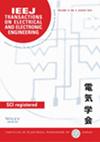求助PDF
{"title":"Classification Method for Fatigue Driving Signals Based on Multiple Classifier Analysis","authors":"Zhendong Mu","doi":"10.1002/tee.24260","DOIUrl":null,"url":null,"abstract":"<p>This study constructs an ensemble learning model under several classifiers by optimizing the hyperparameters of the base classifier to address the low accuracy issue of fatigue driving detection that uses traditional classifiers. In this study, the fatigue driving electroencephalogram (EEG) signals of 26 participants were analyzed using various classifiers, namely, <i>k</i>-nearest neighbor, back-propagation neural network, support vector machine, random forest, Gaussian naive Bayes, and quadratic discriminant analysis, as base classifiers. This study also used 10-fold cross-validation to evaluate the model and four ensemble learning methods, namely, bagging, boosting, stacking, and voting, for comparative analysis. Through the analysis of the EEG signals of the 26 participants, a conclusion could be drawn that the average recognition rate of the ensemble learning model for the participants was improved to 95% after hyperparameter optimization of the base classifier. Moreover, an ensemble learning model was constructed under multiple classifiers to improve the recognition rate of fatigue driving signals. © 2025 Institute of Electrical Engineers of Japan and Wiley Periodicals LLC.</p>","PeriodicalId":13435,"journal":{"name":"IEEJ Transactions on Electrical and Electronic Engineering","volume":"20 4","pages":"647-655"},"PeriodicalIF":1.0000,"publicationDate":"2025-01-23","publicationTypes":"Journal Article","fieldsOfStudy":null,"isOpenAccess":false,"openAccessPdf":"","citationCount":"0","resultStr":null,"platform":"Semanticscholar","paperid":null,"PeriodicalName":"IEEJ Transactions on Electrical and Electronic Engineering","FirstCategoryId":"5","ListUrlMain":"https://onlinelibrary.wiley.com/doi/10.1002/tee.24260","RegionNum":4,"RegionCategory":"工程技术","ArticlePicture":[],"TitleCN":null,"AbstractTextCN":null,"PMCID":null,"EPubDate":"","PubModel":"","JCR":"Q4","JCRName":"ENGINEERING, ELECTRICAL & ELECTRONIC","Score":null,"Total":0}
引用次数: 0
引用
批量引用
Abstract
This study constructs an ensemble learning model under several classifiers by optimizing the hyperparameters of the base classifier to address the low accuracy issue of fatigue driving detection that uses traditional classifiers. In this study, the fatigue driving electroencephalogram (EEG) signals of 26 participants were analyzed using various classifiers, namely, k -nearest neighbor, back-propagation neural network, support vector machine, random forest, Gaussian naive Bayes, and quadratic discriminant analysis, as base classifiers. This study also used 10-fold cross-validation to evaluate the model and four ensemble learning methods, namely, bagging, boosting, stacking, and voting, for comparative analysis. Through the analysis of the EEG signals of the 26 participants, a conclusion could be drawn that the average recognition rate of the ensemble learning model for the participants was improved to 95% after hyperparameter optimization of the base classifier. Moreover, an ensemble learning model was constructed under multiple classifiers to improve the recognition rate of fatigue driving signals. © 2025 Institute of Electrical Engineers of Japan and Wiley Periodicals LLC.

 求助内容:
求助内容: 应助结果提醒方式:
应助结果提醒方式:


